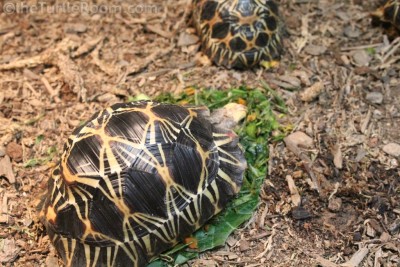Description and Identification
Considered to be one of the world's most beautiful (and arguably the most beautiful) tortoise species, the Radiated Tortoise (Astrochelys radiata) is an unmistakable icon in the chelonian world. This somewhat large tortoise (up to 16" and 35 lbs) stands tall on thick elephantine feet which carry its noticeably arched shell high off the ground. The bulbous black carapace is intricately marked with yellow radiating lines on each scute giving the animal a wonderful display of contrast. These radiating rays or lines give the tortoise its common name. The plastron is also dark with various striations and lines. The blunt snout, face, neck and legs are richly colored yellow and most will have a black patch on the top of the head. Males may sometimes attain larger dimensions when compared to females and may be more elongate. They possess a longer, thicker tail that is carried to the side most of the time. The anal scutes on the plastron of males will widen as they mature to make room for the large tail. Females will usually appear wider and more rounded at the mid section. They exhibit a narrower anal scute opening and a small, stout tail. This species can be incredibly difficult to sex even as they approach adult size. One cannot be absolutely sure of the gender of a Radiated tortoise until it is sexually mature or through edoscopy (a medical procedure which internally takes a look at a tortoise's reproductive organs).
The Radiated tortoise is one of only two tortoise species belonging to the genus Astrochelys, the second being the Ploughshare Tortoise or Angonoka (Astrochelys yniphora). Both of these tortoises share the same, deeply concerning conservation status of critically endangered and they remain on the IUCN's Red List as such.
Despite the critical condition Radiated tortoises remain at in nature, they are doing well in captive situations. Although not the absolute most prolific tortoise species, keepers are having success. Hatchling A. radiata are available on the market in reptile communities across the globe. They are highly sought after and in combination with their beautiful look, they fetch high prices. Their adaptive and hardy nature makes them an excellent choice for enthusiasts if they have the room to house them.
-
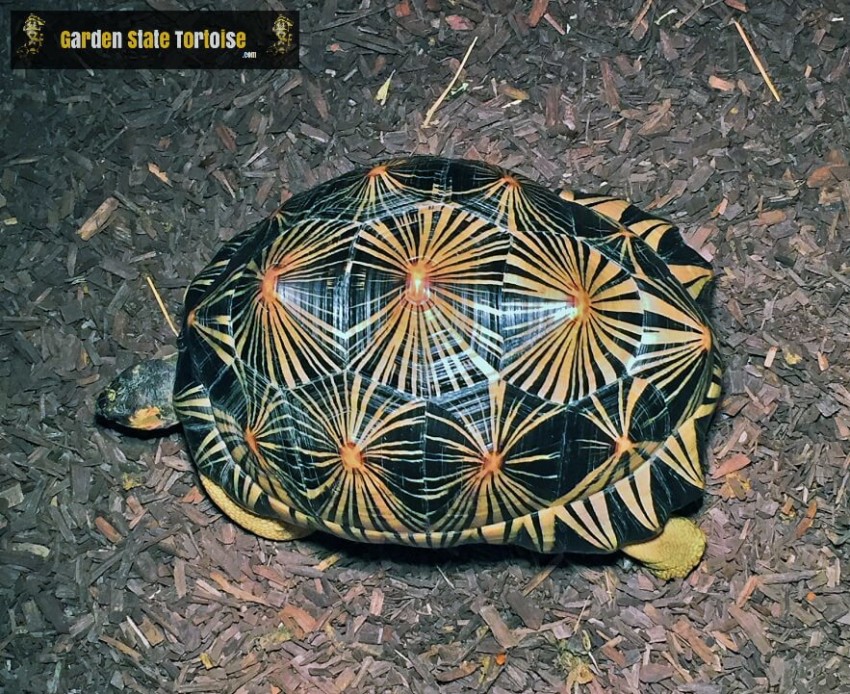 Primary ID: Yellow rays or striations on a black background give this tortoise its namePrimary ID: Yellow rays or striations on a black background give this tortoise its name
Primary ID: Yellow rays or striations on a black background give this tortoise its namePrimary ID: Yellow rays or striations on a black background give this tortoise its name -
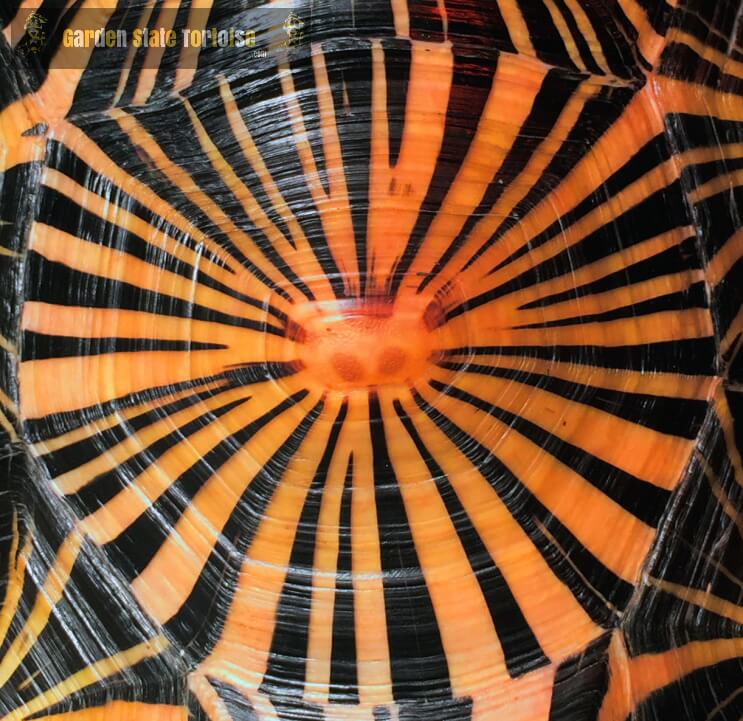 A close-up of a vertebral scute. Note the intricacy of the markings and the gorgeous coloration creating high contrastA close-up of a vertebral scute. Note the intricacy of the markings and the gorgeous coloration creating high contrast
A close-up of a vertebral scute. Note the intricacy of the markings and the gorgeous coloration creating high contrastA close-up of a vertebral scute. Note the intricacy of the markings and the gorgeous coloration creating high contrast -
 An adult pair showing the variation from the dark, more typical specimen (left) to the very vivid specimen (right)An adult pair showing the variation from the dark, more typical specimen (left) to the very vivid specimen (right)
An adult pair showing the variation from the dark, more typical specimen (left) to the very vivid specimen (right)An adult pair showing the variation from the dark, more typical specimen (left) to the very vivid specimen (right) -
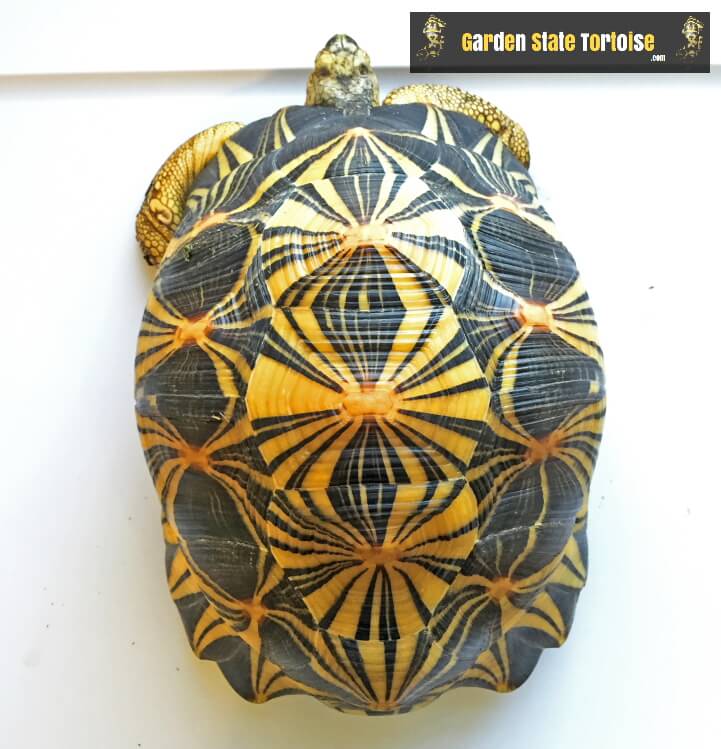 A strikingly attractive adult male showing just how incredible they can lookA strikingly attractive adult male showing just how incredible they can look
A strikingly attractive adult male showing just how incredible they can lookA strikingly attractive adult male showing just how incredible they can look -
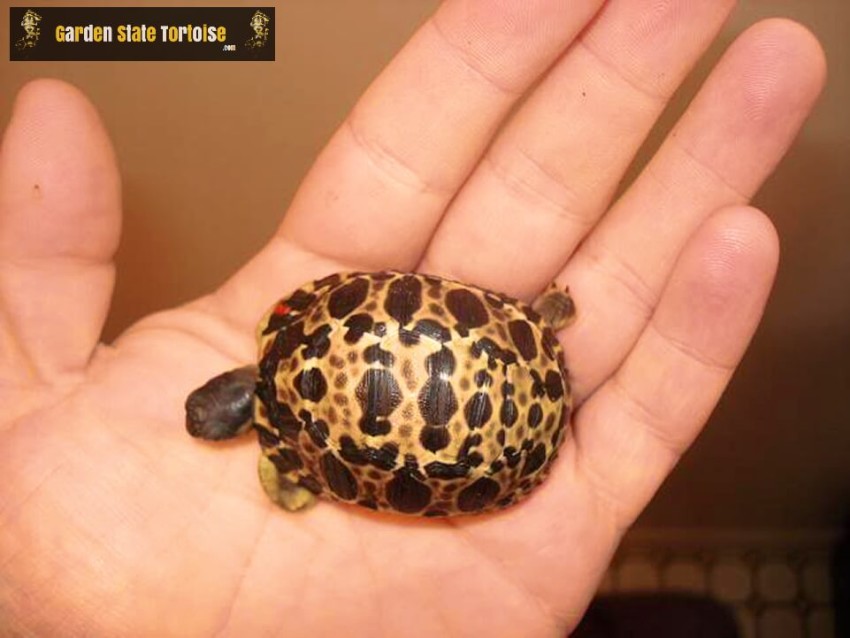 Hatchling Carapace: Hatchlings are not as richly colored as the adults. So tiny, they easily fit in a human palmHatchling Carapace: Hatchlings are not as richly colored as the adults. So tiny, they easily fit in a human palm
Hatchling Carapace: Hatchlings are not as richly colored as the adults. So tiny, they easily fit in a human palmHatchling Carapace: Hatchlings are not as richly colored as the adults. So tiny, they easily fit in a human palm -
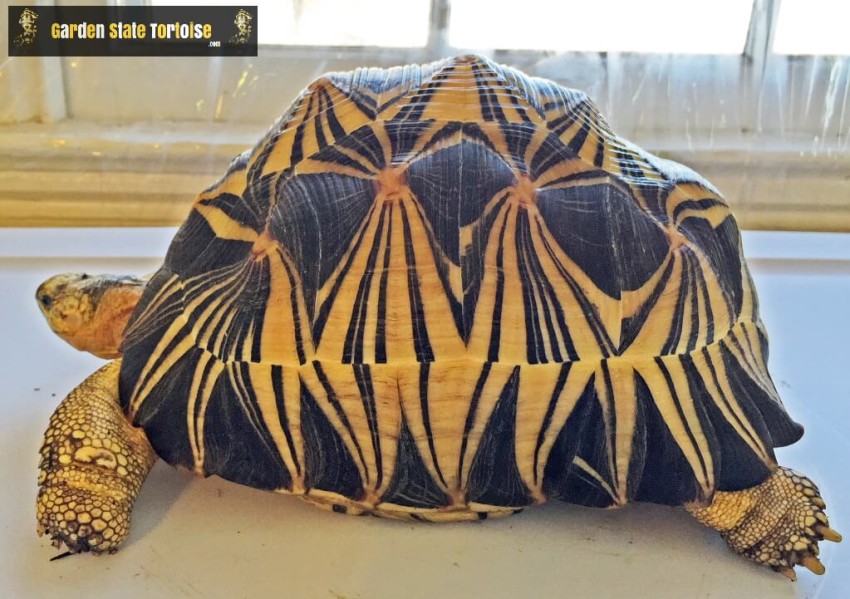 Side View: The classic, highly-arched and brilliantly-marked carapaceSide View: The classic, highly-arched and brilliantly-marked carapace
Side View: The classic, highly-arched and brilliantly-marked carapaceSide View: The classic, highly-arched and brilliantly-marked carapace -
 Hatchling Side View: Although just a few weeks old, the babies already feature the highly-arched carapaceHatchling Side View: Although just a few weeks old, the babies already feature the highly-arched carapace
Hatchling Side View: Although just a few weeks old, the babies already feature the highly-arched carapaceHatchling Side View: Although just a few weeks old, the babies already feature the highly-arched carapace -
 Plastron: Typical plastron markings and coloration for this species. Also note the thick, elephantine feetPlastron: Typical plastron markings and coloration for this species. Also note the thick, elephantine feet
Plastron: Typical plastron markings and coloration for this species. Also note the thick, elephantine feetPlastron: Typical plastron markings and coloration for this species. Also note the thick, elephantine feet -
 Face: Large, dark eyes situated on a bluntly-shaped head with yellow colorationFace: Large, dark eyes situated on a bluntly-shaped head with yellow coloration
Face: Large, dark eyes situated on a bluntly-shaped head with yellow colorationFace: Large, dark eyes situated on a bluntly-shaped head with yellow coloration -
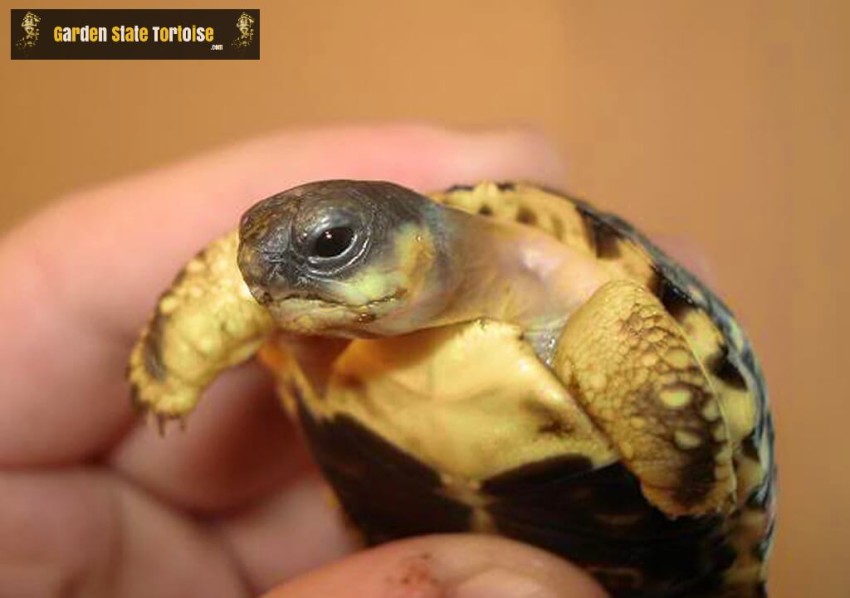 Hatchling Head: Even as babies, the head and face are unmistakableHatchling Head: Even as babies, the head and face are unmistakable
Hatchling Head: Even as babies, the head and face are unmistakableHatchling Head: Even as babies, the head and face are unmistakable -
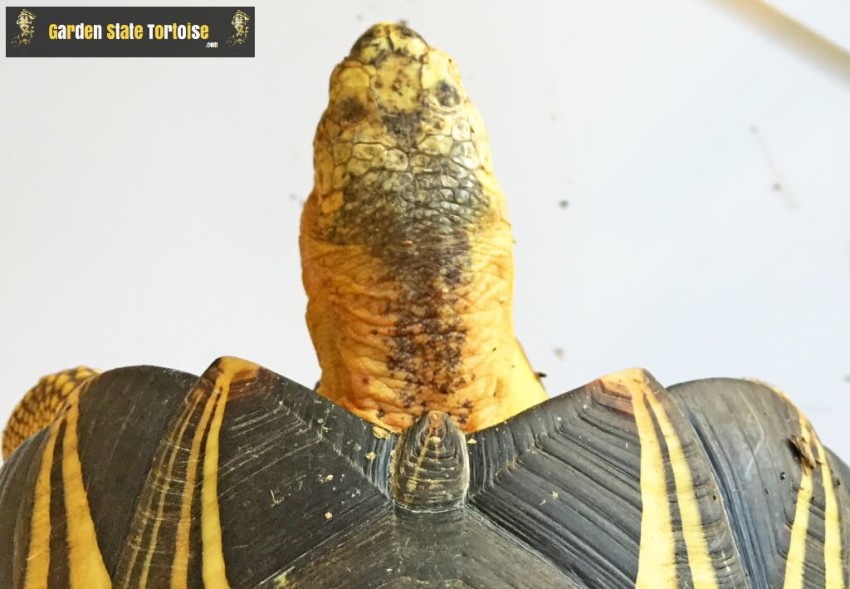 Top of Head: The head is yellow with faint dark markings on the top and, many times, a noticeable black cap or patchTop of Head: The head is yellow with faint dark markings on the top and, many times, a noticeable black cap or patch
Top of Head: The head is yellow with faint dark markings on the top and, many times, a noticeable black cap or patchTop of Head: The head is yellow with faint dark markings on the top and, many times, a noticeable black cap or patch -
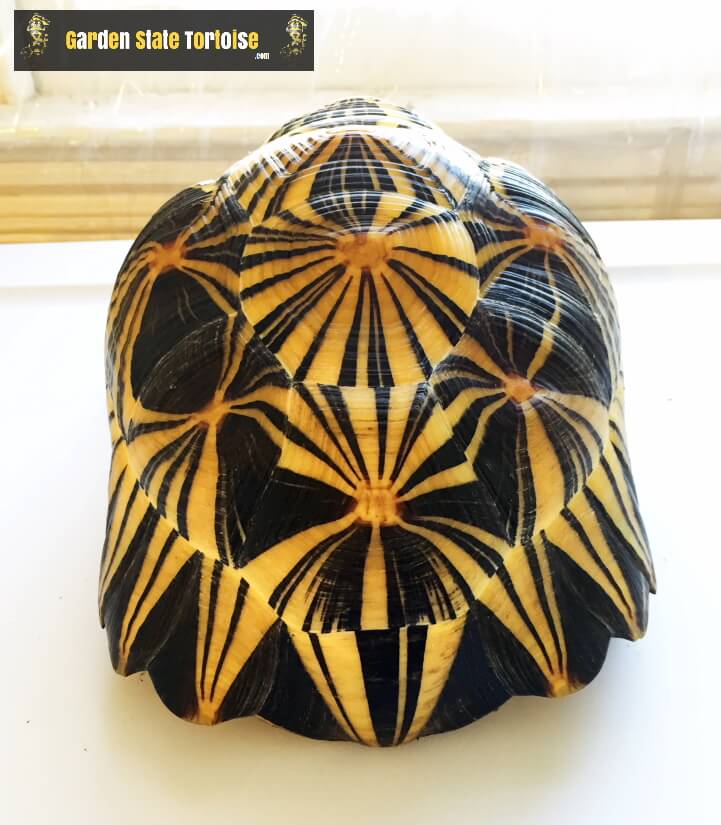 Rear View: From behind, we can easily see the beautifully-marked vertebrals, the deeply-domed carapace, and minimally-flared marginalsRear View: From behind, we can easily see the beautifully-marked vertebrals, the deeply-domed carapace, and minimally-flared marginals
Rear View: From behind, we can easily see the beautifully-marked vertebrals, the deeply-domed carapace, and minimally-flared marginalsRear View: From behind, we can easily see the beautifully-marked vertebrals, the deeply-domed carapace, and minimally-flared marginals
Distribution
One of four native tortoise species, the Radiated tortoise is found in Madagascar where it is also known as the "Sokake". It can be found throughout the island in extremely fragmented groups but it mainly populates the south within a 10,000 km area. In recent times, introduction of this critically endangered animal has occurred on both Mauritius and Reunion, other islands in the general vicinity.
Native Habitat
This species prefers dry tropical forests and parts of the island that provide thorn, bush or woodlands. They may also inhabit areas of tall grass.
Wild Diet
These tortoises spend much of their day grazing on succulents, grasses and fruit. They are highly fond of cactus, particularly those of the Opuntia variety, which were only introduced to the island within the past 300 years, and they are known to be attracted to the color red. There are reports of Radiated tortoises consuming animal matter but we have never witnessed this with our animals.
Behavior
Radiated tortoises typically become active in the morning as they set out to warm up and graze. They will retreat to a shaded area at the peak of the day and may begin moving about again in the early evening. During rain, they will raise themselves up high and wiggle. They may move up and down and side to side almost as if they are attempting to shake the rain off. This is known as "the rain dance" and it can be quite comical to witness.
Reproduction
Radiated tortoises will begin breeding attempts at sizes as small as 11" but most do not successfully accomplish the job until they are 12" or more. Males will combat each other during the breeding season and may become quite aggressive. If a female is encountered, the male will begin by bobbing his head and sniffing her rear. He will then pursue her relentlessly by ramming, pushing, and mounting. During copulation he will emit a serious of hisses and grunts. When ready, the female will excavate a 6-8" deep nesting chamber and deposit anywhere from 3 to 12 eggs (5 or 6 is most common). The relatively long incubation period of between 4 and 7 months results in hatchlings that measure between 1.25 and 1.6". At hatching, they exhibit the highly domed carapace much like the adults do but they are more of a dark gray-black color with off-white markings. This changes with development and age, leading to the spread of rich-yellow radiating lines on a black carapace.
Other Notes
Astrochelys radiata is just one of our planet's truly remarkable chelonian species. In their native Madagascar, their fate is still quite uncertain. It is believed by some that this tortoise is in more trouble than they actually are. It is suspected that flaws in population studies dating back a few decades may have alluded to the assumption that they are so endangered. Today, their numbers in the wild are actually at a surprisingly high level but they have definitely dropped significantly overtime. This possibly concludes that while the Radiated tortoise is in trouble, it may not be to such a high degree. Further studies will help to clear this up. Problems with the economic state in Madagascar causing laws protecting this species to be ignored and the fact that illegal smuggling of them out of the island is still going as of 2014, do still put them at risk.
These tortoises are an absolute joy in captivity and prove to be a hardy, personable and downright gorgeous addition to any collection. However, it should not go without saying that if you reside in the USA, you must contact the United States Fish and Wildlife Service (USFWS) to apply for a Captive Bred Wildlife Permit (CBW) in order to transfer this species across state lines if the animals are being sold or purchased. The Radiated tortoise is listed as CITES Appendix 1 which affords it the steepest ranking of protection making it a globally known endangered species, however, a US citizen may buy, sell and possess them within the state they reside without a CBW permit from USFWS. They may also be gifted across state lines (breeding loans, etc.) without the permit so long as there is no commerce involved.
Care Difficulty:
IntermediateHabitat Difficulty:
AdvancedCaptive Habitat
Adult Radiated tortoises are extremely hardy but need space. During the winter, we house are adults in large, wooden stalls, almost like horse stalls. For a pair of adults we recommend no less then 12x8 feet. Even in this size area, it's important to make sure a male does not become overly aggressive. Be ready to separate if need be. Having extra enclosures on hand, even if they are a bit smaller, is highly advised and is something we practice here. These extra units are ready to house a "bully" or problematic animal if an issue surfaces. The indoor substrate is either cypress or hardwood mulch, 8 to 10" deep. One end of the enclosure is capped off with an entrance cut in so the tortoises can hide. This is filled with straw, not hay; hay tends to mold too quickly. Strong lighting is provided in the form of Zoo Med T5 10.0 fluorescent bulbs (across the enclosure 12-18" above the tortoises) and 160 watt Mercury Vapor bulbs which offer UVA, UVB and heat. Because Radiated tortoises feature highly domed carapaces, it is imperative that you make sure the basking bulbs are far enough above them. Severe burns are caused from these lights being too close and this causes great harm to the tortoises, not to mention, it can start a fire. We keep the bulbs at least 12" above the adults' shells. Our adults are only kept indoors during the harsh winter. In the Spring, they are reunited with the sun and well thought-out pens. An area 20x30 feet for a trio of adults can be constructed using landscaping timbers or other types of pressure treated wood. Stone walls also work well but the tortoises may scrape their shells against it while walking the perimeter. Depending on your area, you may need to remove the existing soil or lawn and replace it with something well drained. We use top soil mixed with pit gravel and sand. Gently sloping areas can be made while decorating the pen which will give the tortoises a more natural terrain to explore. Flat, grassy lawns are not suitable. Various bushes, shrubs, plants and grasses should be added. African grasses, hibiscus trees, spirea, fountain and maiden grasses all help to add character to the outdoor pen. The tortoises will use these for cover and will not hesitate to consume the leaves or flowers of certain ones such as Hibiscus. Of course a shallow water area must be provided for drinking and soaking. Large water pans or cement mixing containers sunken into the ground work well. Choose something large enough for a tortoise to fit its entire body in if it whishes to soak itself. This especially comes in handy on a very hot day. Here at Garden State Tortoise, we make use of cold frames or greenhouses for all the tortoise species we breed. They really come in handy on days of inclement weather or when temperatures are just a little too low. These come in a variety of sizes and models. They are situated onto a wooden or concrete base with an opening which allows the tortoises to come and go as they please. For more information on the use of these at Garden State Tortoise go here. Inside the cold frame a heat lamp with a 250 watt infrared bulb is installed. This can be turned on for additional heat on problematic days especially for tortoise species that cannot cope with chilly weather as well as others. Fully grown Radiated tortoises are not at immediate risk to predation from animals such as raccoons but we advise anyone to predator proof their outdoor pens just to be safe. Theft is a potential threat to tortoise collections as it is so we recommend constructing locking lids made out of pressure treated 2x3's and a heavy duty wire/metal mesh. Situated on hinges, these lids can be locked at night when a possible predator or thief is more inclined to make a move. You can also bring your tortoises indoors at night into a comfortable overnight enclosure and then place them back outdoors in the morning.
Captive Diet
We feed our Radiated tortoises as much of a variety as possible. This species can tolerate some fruit so they do receive it in moderation. Cantaloupe, papaya, strawberries and watermelon are offered occasionally. Opuntia cacti are a favorite food for this species so we offer the pads and fruits. Dandelion, clover, plantain and other excellent weeds make up a good portion of their diet and we make good use of Mazuri tortoise diets. During times of severe heat, the Mazuri can be soaked in Pedialyte to ensure the tortoises are not dehydrating. When weeds and other more valuable food items are not easily accessible, some super market produce can help you to get by. Collard, mustard and turnip greens, curly endive and radicchio are better choices. We do not feed any lettuces of any kind to any of our tortoises.
Calcium is given in the form of cuttle-bone strewn about the enclosures. This way, the tortoises always have it available but it's not being forced down their throats. Calcium powder is sprinkled on their food only sparingly. In the case of gravid females, females who have recently laid eggs or growing youngsters, we will use the powder but only occasionally.
Hatchling Captive Habitat
Like all hatchling tortoises, Radiateds can be fragile at first. However, if kept properly, they will thrive and grow to a more desirable size. A common misconception is the idea that these baby tortoises need to be kept dry and cannot tolerate any humidity. This false statement has led to countless tortoise deaths every year. Radiated tortoises need humidity and access to moistened areas in order to deal with the dry landscape and conditions they occur in. Keeping them too dry will at the very least lead to severe pyramiding of the shell. This is when the scutes of the carapace begin to rise forming points or cones. This can also lead to further deformities concerning their growth. A substrate of coconut coir mixed with organic top soil about 5 to 7" deep is an excellent choice for neonates. It must not be allowed to dry out and it can be kept moist by regularly adding water to it through means of spray bottles and/or simply dumping water directly into it. Be sure it does not become overly saturated. You want it moist, not wringing wet. Some keepers choose to add a bit of sand to help break up the substrate so that it does not cake. While sand has been known to cause blockages or impaction, we have not had a problem in more than 20 years whatsoever when using a small amount to mix in. A shallow water dish must be present at all times for drinking and soaks 3-4 times a week help to aid young A. radiata stay well hydrated. Half logs, cork bark and other cage decor are needed to make the tortoises feel at home or secure. Terra cotta pots with an entrance cut into them can be placed upside down. A regular dish sponge can be soaked and placed on the top of the pots. This creates a nice, humid refuge as the sponge creates humid air inside the pot while keeping it damp. We like to ensure that our young Radiated tortoises are subjected to between 60 and 70% relative humidity with it being 80% or higher inside these hides or within the substrate. Proper lighting can be achieved by using a Zoo Med T5 10.0 fluorescent bulb across the enclosure 12-18" above the tortoises. A daylight basking bulb of 100-150 watts should be placed on one end of the enclosure to allow the animals to bask and warm up at their leisure. They will need this to regulate themselves and digest properly. The temperature at this basking spot should be around 95F. Ambient room temperature should be between 75 and 85F during the day and can drop down to 67-70F at night. No additional nighttime heat source is necessary but be certain there are no drafts. For 1 to 4 hatchling Radiated tortoises, we recommend a 4X2 foot area to start with. You want to make sure the babies have sufficient room to move about but if you go too big, they can become "lost" inside the enclosure. A simple "tortoise table" constructed out of ply wood will work but plain old rubbermaid containers also do the trick quite well. Glass tanks are not suitable for tortoise keeping and should be completely ignored. When using rubbermaids, you can actually put the lid on at night after all lights are turned off. This builds the humidity to a high level and the tortoises benefit from it as they sleep overnight. In the morning, the lid should of course be removed and the lights turned back on. Baby Radiated tortoises can also be kept outdoors when the weather is suitable. Sunny days in the 80F or more range are well received by the youngsters. Be sure to place them in secure pens that no predators can get to. This includes birds! Providing them with the same cage decor mentioned above is necessary. They must be able to hide and escape the sun. Hydration is just as important outdoors so a water dish and regular sprays/mistings should be offered.
Hatchling Captive Diet
Hatchling diet is very similar to that given to the adults. Please read the Captive Diet section for the details. Make sure to soften any pellet foods by soaking them in water for 60 seconds.Other Notes
Astrochelys radiata is just one of our planet's truly remarkable chelonian species. In their native Madagascar, their fate is still quite uncertain. It is believed by some that this tortoise is in more trouble than they actually are. It is suspected that flaws in population studies dating back a few decades may have alluded to the assumption that they are so endangered. Today, their numbers in the wild are actually at a surprisingly high level but they have definitely dropped significantly overtime. This possibly concludes that while the Radiated tortoise is in trouble, it may not be to such a high degree. Further studies will help to clear this up. Problems with the economic state in Madagascar causing laws protecting this species to be ignored and the fact that illegal smuggling of them out of the island is still going as of 2014, do still put them at risk.
These tortoises are an absolute joy in captivity and prove to be a hardy, personable and downright gorgeous addition to any collection. However, it should not go without saying that if you reside in the USA, you must contact the United States Fish and Wildlife Service (USFWS) to apply for a Captive Bred Wildlife Permit (CBW) in order to transfer this species across state lines if the animals are being sold or purchased. The Radiated tortoise is listed as CITES Appendix 1 which affords it the steepest ranking of protection making it a globally known endangered species, however, a US citizen may buy, sell and possess them within the state they reside without a CBW permit from USFWS. They may also be gifted across state lines (breeding loans, etc.) without the permit so long as there is no commerce involved.
If you would like to contribute to the photo gallery of any turtle or tortoise species, please email us at [email protected]. You will be credited for any photos you contribute.
| Astrochelys radiata |
| (Gray, 1873) |
| IUCN Red List: |
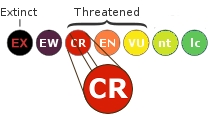 |
| Critically Endangered A4d, E (2008) |
| Order: | Testudines |
| Suborder: | Cryptodira |
| Superfamily: | Testudinoidea |
| Family: | Testudinidae |
| Genus: | Astrochelys |
| species: | radiata |
| Other Common Names: |
| Sokake |
| Old Taxonomy: |
| Testudo radiata, Geochelone radiata |
| CITES: | Appendix I |
| U.S. Legal Status: |
| Listed in the ESA |
Author:
Editors: Stephen J. Enders, Anthony Pierlioni, Chris Leone, Andrew S. Weber, Ben Forrest, and Andrew Hermes
Sources
Disclaimer: The Species Profiles - Natural History, Care Guide, and Photo Gallery database is an educational resource. It does not cover all Chelonian species in the world, nor does it include all the latest scientific information about the species covered. Though we edit our accounts for accuracy, we cannot guarantee all information in those accounts. While theTurtleRoom's staff and contributors provide references to books and websites that we believe are reputable, we cannot necessarily endorse the contents of references beyond our control.

This work by theTurtleRoom is licensed under a Creative Commons Attribution-NonCommercial-ShareAlike 4.0 International License.










